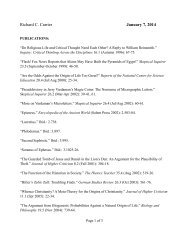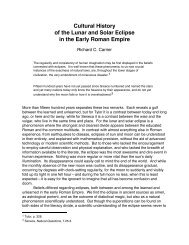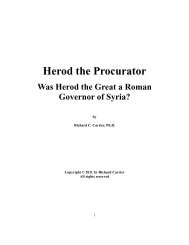“Bayes' Theorem for Beginners: Formal Logic and ... - Richard Carrier
“Bayes' Theorem for Beginners: Formal Logic and ... - Richard Carrier
“Bayes' Theorem for Beginners: Formal Logic and ... - Richard Carrier
Create successful ePaper yourself
Turn your PDF publications into a flip-book with our unique Google optimized e-Paper software.
15. When you genuinely don’t know what is typical, or have no idea what would be<br />
typical (i.e. if you had no idea whether it was common <strong>for</strong> students to lie or dogs to eat<br />
homework), then the prior probabilities are equal, i.e. P(h|b) = 0.50 <strong>and</strong> P(~h|b) = 0.50, if<br />
you would agree there is as much chance of one hypothesis being true as the other<br />
(margins of error can still be assigned depending on how uncertain you are of even that).<br />
16. All that aside, we will assume <strong>for</strong> our example that P(h|b) = 0.10 <strong>and</strong> P(~h|b) = 0.90<br />
(our first estimates, i.e. we estimated that typically 90% of all ‘dog ate my homework’<br />
stories are false, <strong>and</strong> only 10% are true). There<strong>for</strong>e:<br />
32<br />
0.10 x P(e|h.b)<br />
P(h|e.b) = __________________________________<br />
[ 0.10 x P(e|h.b) ] + [ 0.90 x P(e|~h.b) ]<br />
Determining Consequent Probabilities<br />
1. There are two prior probabilities in the Bayesian equation (which together sum to 1,<br />
covering a complete probability space) <strong>and</strong> two consequent probabilities (which do not have<br />
to sum to 1 or any other value, as they are completely independent of each other). The<br />
first consequent probability is that of having the evidence we do if h is true, the second consequent<br />
probability is that of having the evidence we do if h is false. Those four values<br />
complete the Bayesian equation. They are in effect four premises in a <strong>for</strong>mal logical<br />
argument, so if you can defend these premises, you can defend the conclusion.<br />
2. If there is no reason to expect any evidence of the incident other than the missing<br />
homework (<strong>and</strong> the student’s story), then the probability of having the evidence we do if<br />
h (“the dog ate the student’s homework”) is true is 100% (because we have exactly what<br />
we expect <strong>and</strong> nothing more nor less), as high as can be, <strong>and</strong> there<strong>for</strong>e:<br />
P(e|h.b) = 1.00 (common case)<br />
3. What would it take to lower this value? If any of the evidence we have were contrary<br />
to expectation. For example, if you think there was a small chance (say, 20%) that your<br />
student, given her story, could at least produce scraps of dog-mangled homework as<br />
evidence, then your student’s inability to produce that evidence is somewhat contrary to<br />
expectation, <strong>and</strong> there<strong>for</strong>e the absence of this expected evidence drops the probability of<br />
all the evidence we have by as much as the missing evidence is expected, in other words<br />
by 20% (or 0.20). There<strong>for</strong>e:<br />
P(e|h.b) = 1.00 – 0.20 = 0.80 (case with small incongruity)








